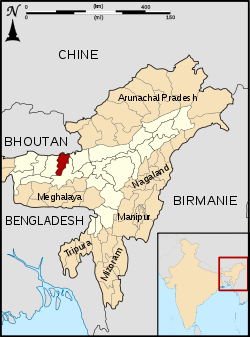Nalbari district
Nalbari (Pron: nɔ:lˈbɑ:ri) is an administrative district in the state of Assam in India. The district headquarters is located at Nalbari.
Nalbari district | |
|---|---|
District | |
 Nalbari district's location in Assam | |
| Country | |
| State | Assam |
| Division | Lower Assam |
| Headquarters | Nalbari |
| Area | |
| • Total | 2,257 km2 (871 sq mi) |
| Population (2011) | |
| • Total | 771,639 |
| • Density | 340/km2 (890/sq mi) |
| Demographics | |
| • Literacy | 79.89% |
| • Sex ratio | 945 |
| Time zone | UTC+05:30 (IST) |
| ISO 3166 code | IN-AS |
| Website | http://nalbari.nic.in/ |
History
Nalbari was declared a sub division of undivided Kamrup District in 1967. The district was created on 14 August 1985 when it was split from Kamrup district.[1] 1 June 2004 saw the formation of Baksha District from parts of three districts, including Nalbari.[1]
Geography
Nalbari district occupies an area of 2,257 square kilometres (871 sq mi),[2] The latitude of Nalbari is 26 degrees north and 27 degrees north and the longitude is 91 degrees east and 97 degrees east. The tributaries of the Brahmaputra, the Nona, Buradia, Pagaldia, Borolia and Tihu, which originate in the foothills of the Himalayan Range, are wild in nature and make an enormous contribution to the agrarian economy of the district.
Demographics
According to the 2011 census Nalbari district has a population of 771,639,[3] This gives it a ranking of 488th in India (out of a total of 640).[3] The district has a population density of 763 inhabitants per square kilometre (1,980/sq mi) .[3] Its population growth rate over the decade 2001-2011 was 11.74%.[3] Nalbari has a sex ratio of 945 females for every 1000 males,[3] and a literacy rate of 79.89%.[3]
| Year | Pop. | ±% p.a. |
|---|---|---|
| 1901 | 91,724 | — |
| 1911 | 103,949 | +1.26% |
| 1921 | 118,705 | +1.34% |
| 1931 | 151,846 | +2.49% |
| 1941 | 196,535 | +2.61% |
| 1951 | 231,698 | +1.66% |
| 1961 | 329,736 | +3.59% |
| 1971 | 429,760 | +2.68% |
| 1991 | 603,307 | +1.71% |
| 2001 | 689,053 | +1.34% |
| 2011 | 771,639 | +1.14% |
| source:[4] | ||
Hindu Population in the district is 491,582 (63.71%), while Muslim population is 277,488 (35.96%) according to 2011 census.
Education
The rate of total literacy of the Nalbari District, according to 2011 census, is 79.89% as against 80.95% in 2001. The rural literacy rate is 78.44%, while the urban rate is 91.46%. Male literacy is 85.58% consisting of Rural 84.38% and Urban 95.24%. Female literacy is 73.85% consisting of Rural 72.14% and Urban 87.48%. The total literacy rate of the state as a whole is 73.18%.[6]
See also
References
- Law, Gwillim (25 September 2011). "Districts of India". Statoids. Retrieved 11 October 2011.
- Srivastava, Dayawanti et al. (ed.) (2010). "States and Union Territories: Assam: Government". India 2010: A Reference Annual (54th ed.). New Delhi, India: Additional Director General, Publications Division, Ministry of Information and Broadcasting (India), Government of India. p. 1116. ISBN 978-81-230-1617-7.CS1 maint: extra text: authors list (link)
- "District Census 2011". Census2011.co.in. 2011. Retrieved 30 September 2011.
- Decadal Variation In Population Since 1901
- www.census2011.co.in/data/religion/district/163-nalbari.html
- "Census 2011". censusindia.gov.in. Retrieved 24 May 2012.